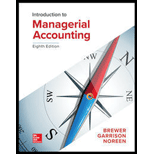
Cane Company manufactures two products called A1pia d Beta that sell for $120 and $80, respectively. Each product uses only one type of raw material that costs $6 per pound. The company has the capacity produce 10,0000 units of each product Its average cost per unit for each product at this level of activity are given below: 
The company considers its traceable fixed manufacturing
Required:
(Answer each question independently unless instructed otherwise.)
Assume that Cane normally produces and sells 40,000 Betas per year. What is the financial advantage (disadvantage) of discontinuing the Beta product line?
Concept Introduction:
Financial advantage (disadvantage): Financial advantage (disadvantage) refers to the incremental profit or loss, a company will earn in situations like acceptance of a special order, dropping of a business line, etc.
It is calculated by only considering the relevant costs. The incremental revenues and incremental costs are taken together to calculate financial advantage or disadvantage. Financial advantage refers to incremental net operating income and financial disadvantage refers to incremental net operating loss.
To calculate:
Financial advantage (disadvantage) of discounting Beta from operations.
Answer to Problem 7F15
Solution:
The financial advantage of discounting Beta from operations is $200,000 as Beta was earning - $ 200,000 as net operating loss considering all the relevant costs.
Explanation of Solution
The financial advantage (disadvantage) will be the net operating income lost due to discontinuance of Beta.
Note: The common fixed expenses are unavoidable, thus they are irrelevant costs here.
Net operating income (considering all the relevant costs) −
| Net Operating Income from − Beta | ||
| Sales revenue ($ 80 per unit X 40,000 units) | 3,200,000 | |
| Less: Variable expenses | ||
| Direct Material ($ 12 per unit X 40,000 units) | 480,000 | |
| Direct Labor ($ 15 per unit X 40,000 units) | 600,000 | |
| Variable manufacturing overhead ($ 5 per unit X 40,000 units) | 200,000 | |
| Variable selling expenses ( $ 8 per unit X 40,000 units) | 320,000 | |
| Total variable expenses | 1,600,000 | |
| Less: Traceable fixed manufacturing overhead ( $ 18 per unit X 100,000 units) | 18,00,000 | |
| Net Operating Loss from - Beta | (200,000) | |
Given, the information for the product Beta −
- Regular sales units = 40,000 units
- Selling price per unit = $ 80 per unit
- Direct Material per unit = $ 12 per unit
- Direct Labor per unit = $ 15 per unit
- Variable manufacturing overhead per unit = $ 5 per unit
- Variable selling expenses per unit = $ 8 per unit
- Traceable fixed manufacturing overhead = $ 18 per unit
Calculations:
- Sales revenue
- Total Variable expenses
- Total traceable fixed manufacturing overhead −
- Net operating loss
Thus, the financial advantage of discounting Beta from operations is $ 200,000.
.
Want to see more full solutions like this?
Chapter 11 Solutions
Introduction To Managerial Accounting
- Tulsa's gross profit percentage is:arrow_forwardWhat is the correct answer general Accountingarrow_forwardDepartment A had 15,000 units in work in process that were 60% completed as to labor and overhead at the beginning of the period; 45,600 units of direct materials were added during the period; 42,500 units were completed during the period, and 11,000 units were 80% completed as to labor and overhead at the end of the period. All materials are added at the beginning of the process. The first-in, first-out method is used to cost inventories. The number of equivalent units of production for conversion costs for the period was ____ Units.arrow_forward

 AccountingAccountingISBN:9781337272094Author:WARREN, Carl S., Reeve, James M., Duchac, Jonathan E.Publisher:Cengage Learning,
AccountingAccountingISBN:9781337272094Author:WARREN, Carl S., Reeve, James M., Duchac, Jonathan E.Publisher:Cengage Learning, Accounting Information SystemsAccountingISBN:9781337619202Author:Hall, James A.Publisher:Cengage Learning,
Accounting Information SystemsAccountingISBN:9781337619202Author:Hall, James A.Publisher:Cengage Learning, Horngren's Cost Accounting: A Managerial Emphasis...AccountingISBN:9780134475585Author:Srikant M. Datar, Madhav V. RajanPublisher:PEARSON
Horngren's Cost Accounting: A Managerial Emphasis...AccountingISBN:9780134475585Author:Srikant M. Datar, Madhav V. RajanPublisher:PEARSON Intermediate AccountingAccountingISBN:9781259722660Author:J. David Spiceland, Mark W. Nelson, Wayne M ThomasPublisher:McGraw-Hill Education
Intermediate AccountingAccountingISBN:9781259722660Author:J. David Spiceland, Mark W. Nelson, Wayne M ThomasPublisher:McGraw-Hill Education Financial and Managerial AccountingAccountingISBN:9781259726705Author:John J Wild, Ken W. Shaw, Barbara Chiappetta Fundamental Accounting PrinciplesPublisher:McGraw-Hill Education
Financial and Managerial AccountingAccountingISBN:9781259726705Author:John J Wild, Ken W. Shaw, Barbara Chiappetta Fundamental Accounting PrinciplesPublisher:McGraw-Hill Education





